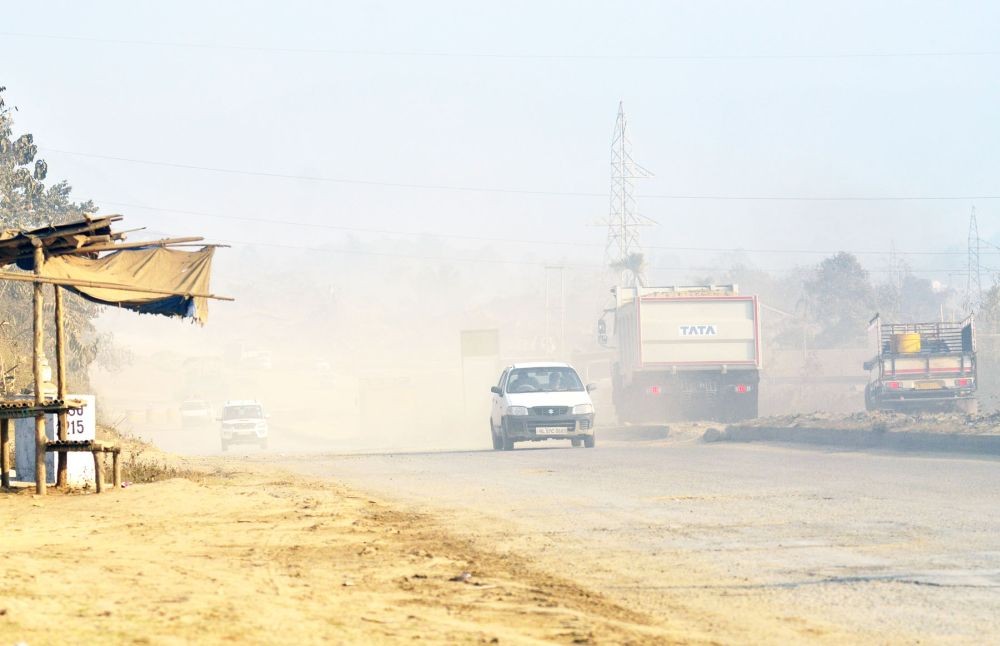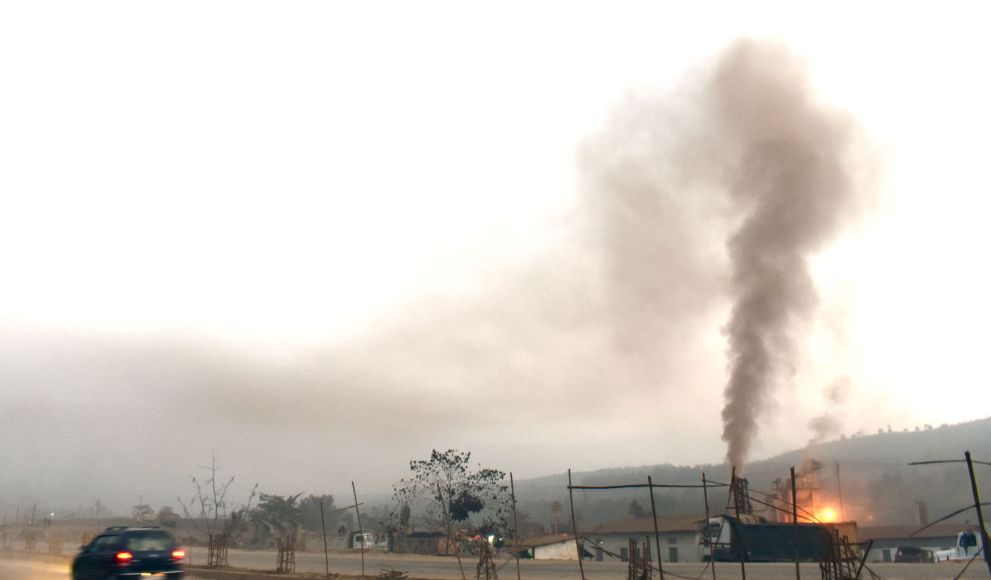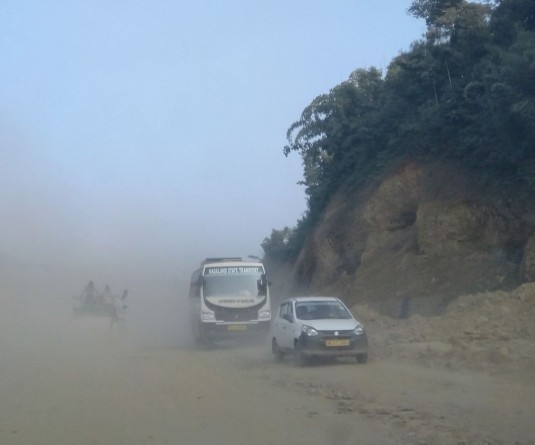A constant surge of dust kicked up by vehicles envelopes the air on the highway at Kukidolong, near Jharnapani. (Photo courtesy: Caisii Mao)

A blight of dust and smog from 4-lane construction
Imkong Walling
Dimapur | January 22
A public road expansion venture of great economic significance to Nagaland is turning out to be a great health concern.
A haze of dust hovers in the air surrounding the Kuki Dolong area and Jharnapani in Dimapur, reminiscent of the annual Delhi smog phenomenon.
It may not be palpable to the commuters on the all-important Dimapur to Kohima highway, which is in expansionary mode, but to the local residents and workers engaged in the project, it has become a constant companion for some two years now. A companion of fine dust, kicked up into the air by the road expansion works and vehicles, which they are compelled to breathe in, by circumstance.
As seen from across the road, smoke released from one of the stone-crushers installed beside the highway at Kukidolong, near Jharnapani. (Morung Photo)
One of the main contributors to the haze appears to be a boulder-crushing unit installed beside the highway for supplying stone gravel to the 4-lane construction.
To comprehend the scale of the pollution, one has to take a panoramic view of the landscape from the hill in Molvom village south of the highway across the river from Kukidolong village.
As told to The Morung Express by one Jharpani resident, “If you can just visit the STF camp at Molvom village and take a look from there, you can see the exhaust column from the stone crusher rising sky high and spreading in a haze covering the entire hill areas above the national highway.”
However, gaining access to the police camp on the hilltop in Molvom for an unobstructed view of the highway and watch the scene as described is restricted.
He added, “One look is enough to cause concern and it’s been going on for more than a year.”
A bid to enter the camp, this week, to photograph the scene was unsuccessful as the sentries denied entry. Down on the highway, the boulder-crushing unit was shut for lunch. It comprised of atleast four stone-crushers.
Overlooking this bustling unit to the north-east is the hill face, dotted with trees, along which the highway snakes along. It looked like the trees would require a few good bouts of rain to wash off the thick coat of dust that has settled on the leaves.
All things with a roof, including the labour camps and vehicles, in the vicinity of Kukidolong village presented the same picture- covered in a blight of dust. According to the person, who is an ICAR employee and wished not to be named, the dust-covered scene is replicated as far up as Jharnapani and the surrounding places.
“I believe it is a cause for alarm since it’s a public health hazard,” he added.
Mitigation missing
There has however been no effort to mitigate the health concern. Accusing the authorities of indifference, a resident of Kukidolong said, “The disconcerting thing is that ‘they’ have taken no measures to ease the pollution. They are unconcerned of the ill effects.”
“It is for development. It’s good, it’s for everybody. However, it should not come at the cost of public health.”
The collective ‘they’ he averred to were the government authorities, village councils in the affected area and the people building the road. As for the residents taking up the matter with the authorities, he said that they are collectively contemplating writing to the district administration.
Nasal irritation and coughs are said to have become common. He said that his wife has a history of respiratory complaints and the prevailing smog is only aggravating the condition. “I had no such problem before I moved here. But I have also started developing respiratory problems.”
“It’s the worst in the morning. The air is rancid, filled with the smell of burned coal tar, while thick smog envelopes the surrounding. It feels like there is a thick cloud. We see the sun only after 8:00am. It has been like this since the construction started,” he claimed.
He estimated that there could be around a 1000 households in the area and other residents like him are facing the same situation but helpless and compelled to stay on.
A visitor to the place, asked to comment on the prevailing air condition, said, “These are the side-effects of development.
We’ll have to strike a balance between development and environment (as well as health). Else it will be difficult for us to live. For the sake of development, we cannot sacrifice our lives.”
He further wondered if the requisite environmental clearance was applied or issued by the authorities in concern.
He wished to be quoted only as an unnamed visitor, who was visiting family.







